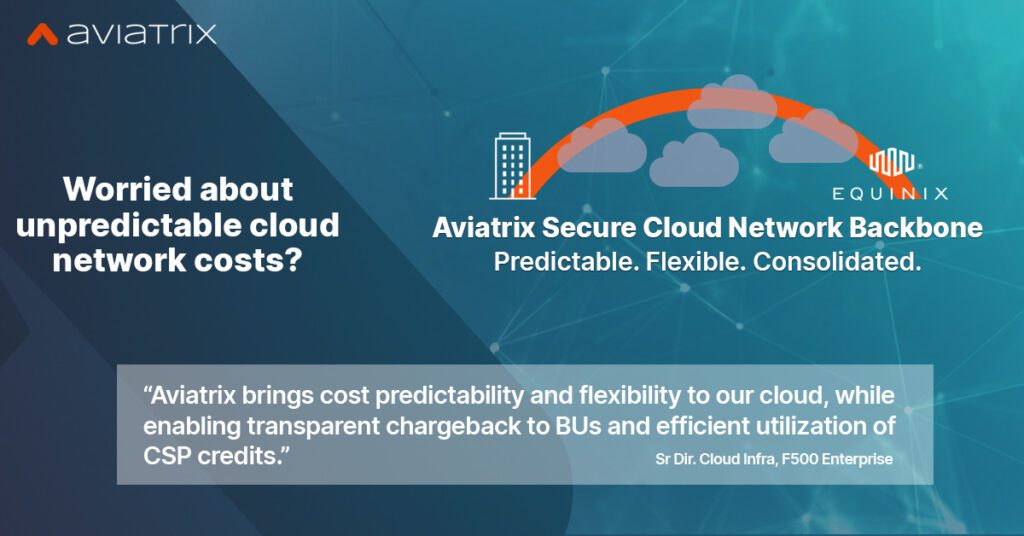The cost of cloud services is influenced by a complex web of factors, often resulting in unexpected bills. In a recent conversation I had with one CIO, he mentioned that they had allocated $5 million for their annual cloud budget but ended up paying $15 million. A 3x escalation in budget is not easy to swallow by any enterprise. So, what happened?
The answer is more common than you might expect – small factors that added up to one giant bill. In this blog we’ll focus on networking factors that play into this equation.
Business Challenges with Cloud Networking Costs
According to Forrester: “Today more than eight in 10 data management decision-makers (82%) cite forecasting and controlling costs as a data ecosystem challenge. Usage-based pricing models that coincide with cloud computing introduce month-to-month cost variability. What was once meticulously planned and budgeted on-premises, is now unpredictable. As data volume and usage expands, opacity impedes both general accounting and opportunities to drive cost efficiency. Without the ability to predict and manage cloud costs, decision-makers can find themselves quickly over budget.”
There are four key challenges that frequently spur enterprises’ cloud cost-related problems:
1. Lack of cost predictability
The cost of cloud networking can be unpredictable because it’s mainly based on pay-as-you-go models. As you add more network components and usage increases, the cost of infrastructure, complexity, and required staff to maintain operations goes up. Additionally, the cost is spread across different accounts and services like Direct Connect, Shared VPC, transit attachments, egress charges, NAT, and firewalls. Without detailed usage information and the ability to analyze trends, accurately predicting cloud network costs is extremely difficult.
2. Lack of flexibility
When budget owners allocate a certain amount of money for cloud initiatives, they want the technical teams to have some wiggle room to exceed that amount without having to find additional funding. Businesses prefer budgets that are predictable but also allow for some flexibility, so they can plan for consistent usage and adjust future budgets accordingly.
3. Inaccurate allocation of shared service costs
Cloud networks consist of some components that are easier to charge back such as managing VPC/VNets. However, there are also shared services components that are used by everyone, such as Shared Services VPC/VNet, SaaS access, AWS Direct Connect, Azure ExpressRoute, IPSec VPN connections, etc. Allocating costs accurately among teams becomes challenging without visibility into variable network usage. Often, for the sake of simplicity, the costs are divided equally among teams, even if one team didn’t use the service, leading to inaccurate and unfair cost allocation.
4. Inefficient utilization of CSP credits
Businesses often have agreements with cloud service providers (CSPs) to get better rates by committing to a certain level of spend. Since large enterprises use multiple cloud providers, they want the additional flexibility to choose which provider to be billed through, so they can make use of their credits and maintain the discounts they’ve negotiated.
Technical Challenges with Cloud Networking Costs
Let’s double click on the technical reasons behind these challenges:
- Network Management: The cost of managing a cloud network is complex as it not only includes the infra cost (e.g. AWS TGW or Virtual WAN attachments) but also factors like personnel, hours, tools, and training which are harder to quantify.
- Varying Pricing Models: Many networking services are compute dependent so choosing right sizing and tiering (Reserved, Spot, etc.) is critical. Data transfer rates are complex and vary based on region and pattern, intra- vs. inter-AZ, public vs. private IP, egress vs. ingress, direct connect, etc.
- Resource Consumption: Cloud offers easy scaling which directly impacts compute, data transfer, and network usage. More networks (VPC, VNet, IPSec Tunnels, VPN Users), design choices such as dedicated security VPC vs. security embedded in the data path have huge impact.
- Service Interdependencies: Service components are often spread across AZ, region, clouds, on-prem, internet, etc. It’s complicated to preemptively map out those dependencies and traffic engineer for low-cost and low-latency.
- Varying Prices: Different cloud providers have different pricing for similar services, which keeps changing. For example, AWS Direct Connect is $0.02/GB whereas OCI FastConnect has no data charges. Enterprises love the ability to flexibly benefit from these dynamic pricing models for better cost, service, and performance.
- Egress and NAT Charges: Egress charges are one of the costliest and most overlooked components of cloud networking. In addition, if you are using a NAT Gateway, it has compute and additional data processing charge.
How Aviatrix Secure Cloud Network Backbone Improves Cloud Cost Management (CCM)
With Aviatrix Secure Cloud Network Backbone, cloud networking cost management is simple. Aviatrix becomes the consolidated network provider for most of the network services. Although some network components are still billed by CSP and there is a component of variability, with Aviatrix, customers get to easily choose desired low-cost, low-latency paths which can bring those variances down. Customers can greatly save on egress costs and expand to new regions and clouds without spending on new circuits (AWS Direct Connect, ExpressRoute etc.). The native high-speed encryption and baked-in security capabilities of Aviatrix Secure Cloud Network Backbone allow customers to reduce spend and consolidate contracts.

Aviatrix provides real-time and historical visibility, offering complete insight into network usage by all cloud accounts, subscriptions, and projects. Businesses can therefore easily analyze usage trends to identify and reallocate underutilized resources, identify areas for cost-optimization, and plan for future cloud expenditures. With Aviatrix, businesses can go over budget with the overconsumption allowance, giving them greater flexibility to accommodate unplanned and critical business initiatives.
“Aviatrix’s flexible billing plans allowed us to have predictability into our cloud spend without compromising on the flexibility to accommodate unplanned yet critical business initiatives. Their overconsumption allowance feature allowed us to act without any surprises. Moreover, Aviatrix’s CostIQ feature allowed us to charge back cloud cost to respective business units, creating a culture based on transparency. Aviatrix as a multicloud platform enabled us to be billed through the CSP of our own choice and effectively utilize our CSP credits.” – Senior Director Cloud Infrastructure, Fortune 500 Enterprise
Aviatrix also allows for accurate cost allocation based on actual network usage to shared cloud services, which FinOps teams can leverage for chargeback/showback to easily distribute cost appropriately.
Watch this short demo to learn how CostIQ leverages network flow telemetry built in Aviatrix Secure Cloud Network Backbone.
Lastly, Aviatrix offers a unique capability where the network usage billed by Aviatrix can be processed via any CSP marketplace of choice. Customers can change the allocation as and when they desire to meet their individual CSP spend commitments.
Trying to gain control of your cloud costs? Wondering what other common challenges enterprises frequently encounter with cloud networking and security (and how to avoid them)? Download our Ebook and get practical steps for turning your cloud network into the business enabler it was always meant to be.
To learn more about strategies for optimizing existing cloud spend, check out Futuriom’s 2023 Cloud Cost Management and FinOps Report.
Scan this QR code to get in touch now:



